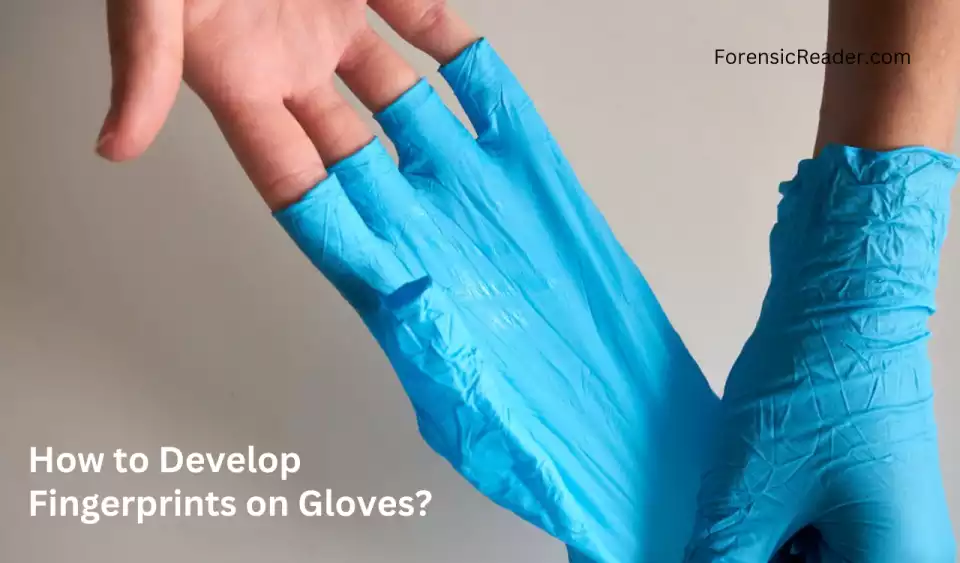Key Notes:
- Even if hands and palms are fully covered they are still useful in obtaining useful information from the contact area.
- Myths: Fingerprints are not left on fabric gloves.
- Thicker gloves do contain fingerprints if you sweat more.
- Fingerprint Development Method: VMD, powder suspension, and chemical stain
- Deposits such as oil, grease, or dust outside of a thin glove can increase the chance of getting fingerprints on the outer surface.
Possibility of Getting Fingerprints on Gloves
There are different types of gloves available in the market. Some of them are able to hide your fingerprint when you touch any external surface while some don’t. It majorly depends on the thickness and material they are made of.
In any case, the fingerprints were majorly incomplete or partial. Here is the table for the common types of gloves and whether they leave fingerprints on the surface
| Gloves Material | Thickness | Fingerprint Possibility on Touching External Surface | Fingerprints on Gloves Interior |
|---|---|---|---|
| Latex (Medical Use) | 4-8 mils* | Possible | Possible |
| Nitrile Gloves | 5 mils and less* | Highly Unlikely | Possible |
| Vinyl Gloves | 4 mils and less* | Highly Unlikely | Possible |
| Thick Rubber Gloves | About 1mm | Highly Unlikely | Possible |
| Fabric | 1 mm and more | Impossible | Possible (if uniform surface) |
| Leather | 2 mm and more | Impossible | Possible (if uniform surface) |
| Kevlar | About 2 mm | Impossible | Possible (if uniform surface) |
Based on the above table data, you can say:
A. On External Surface: 99% of gloves do hide fingerprints while some aren’t. It depends majorly on the thickness and material they are made of.
In addition, oil, grease, dust, and natural deposits (if you sweat more), the chance of getting fingerprints on touched surfaces increases, especially when you’re wearing thin gloves like those used in hospital latex or nitrile.
So, one should avoid latex, nitrile, or other thin rubber gloves. While, fabric, leather, and kevlar gloves prove to be the best for completely hiding the fingermarks on the external surface.
B. On Interior of Gloves: Nearly all types of gloves can have fingerprints which can be developed using forensic means.
It is a myth that gloves don’t capture fingerprints. Methods such as VMD, powder suspension, and chemical stain are proven useful in developing fingerprints even on fabric gloves.
How Long do Fingerprints Stay on Gloves?

Fingerprints can stay as long as they are not disturbed. In research by Hunter et.al., these researchers were able to successfully develop identifiable prints on gloves that are 25 years old. They used Coomassie blue stains that react with the organic solvent to develop prints.
For other rubber gloves, the time may be nearly identical to latex ones. But as the thickness increases, the chance of getting fingerprints increases because thicker rubber tends to have
Why do Latex/Nitrile Gloves are Not Good at Hiding Fingerprints?
Because of thickness and surface type:
- On External Surface: Rubber gloves such as latex, vinyl, or nitrile are thin and finger ridges may be able to leave fingerprints on the external surface especially when they are pressed hard against the surface.
- Inside the Gloves: Rubber gloves have a smooth surface that is able to catch fingerprints easily as compared to fabrics that have absorbent surfaces.
Read More: 11 Reasons Why Fingerprints Used for Identification: A Forensic Aspect
Fabric Gloves Hide Fingerprints? A Myth
It is a myth that fabric gloves don’t leave fingerprints on the interior surface. I think they do.
I have studied in my Master’s of Forensic Science that fingerprints can be developed on clothes and they do capture fingerprints on their surface.
Inside Fabric Gloves: Usually, they have repetitive patterns that need to be removed by a software algorithm to get clear fingerprints.
Recently, I was watching one of the Forensic Files: Nice Thread episodes in which forensic expert Eric Berg is facing a problem in developing fingerprints on clothes.
The prints are made from blood and they are obscured by the thread. So, he took a photograph of it and then scanned it on the computer.
He found that the thread pattern was uniform throughout the screen. He then developed a mathematical algorithm to remove the background. Finally, he got the fingerprints he was looking for.
Berg’s efforts finally solved the case.
So, you can’t be sure that your fingerprints can’t be inside fabric or leather cloth gloves.
What If Gloves are Found? Can They Trace Back to the Owner?

Though some gloves don’t leave fingerprints, they can be other major clues.
As per the Locard exchange principle—there is an exchange of material— and gloves follow the same.
From gloves, your sweat, dead cells, and hair can easily be transferable to the inner surface of gloves which can be a marker for obtaining DNA and fingerprints.
With proper scientific analysis, there is a good chance that abandoned gloves can be traced back to the owner.
So, yes, finding fingerprints on Gloves can be hard but there is a good chance of getting fingerprints if they are made from rubber material than cotton ones.
- Rubber Gloves (latex/Nitrile/Vinyl): A higher chance of getting fingerprints and DNA. Fingerprints can stay longer period to time. However, due to environmental and bacterial conditions, there is a higher chance of DNA contamination with time.
- Fabric Gloves: Higher chance of getting DNA from the absorbed sweat. Like rubber gloves, they do suffer from DNA degradation with environmental and bacterial growth.
- Leather Gloves: They resist bacterial growth and have a hence higher chance of getting DNA than rubber and regular fabric gloves.
- Kevlar Gloves: They are good at both hiding fingerprints and DNA.
| Gloves Material | Fingerprints Inner Side | Possibility of Getting DNA |
|---|---|---|
| Latex (Medical Use) | Highly Possible | Possible |
| Nitrile Gloves | Highly Possible | Possible |
| Vinyl Gloves | Highly Possible | Possible |
| Thick Rubber Gloves | Highly Possible | Possible |
| Fabric | Highly Unlikely | Possible |
| Leather | Possible (if smoother inner surface) | Possible |
| Kevlar | Highly Unlikely | Possible |
So, whether you’re wearing latex or fabric gloves, the chance of finding fingerprints varies but getting DNA from sweat or other biological material can easily be used to make a DNA profile of the person who wore those gloves.
Read More: 47 Branches of Forensic Science: Disciplines and Division With Evidence and Case Types
How to Develop Fingerprints on Gloves?

Material Required:
- Pair of Latex or Fabric gloves
- Magnetic powder and Iodine Fuming methods used
Procedure:
- Wore latex gloves in one hand and fabric gloves in another.
- Wear it for at least 10-15 minutes to enhance the sweating.
- Remove the gloves by pulling from the wrist area to the fingers.
- Using a scissor, cut the gloves in a manner so that both the flaps are superimposable.
- For latex gloves use the magnetic powder method.
- For fabric gloves use the Iodine fuming method for fingerprint development.
Note: Photograph the developed fingerprints from Iodine fuming as with time, the prints may be washed out. However, the prints can be redeveloped.
Research Findings:
- Pleckaitis (2007) uses a powder suspension method to develop finger ridges on the interior of latex and nitrile gloves.
- Jones et al. (2003b) found that Multimetal deposition II (MMD II) was particularly effective on problematic surfaces such as latex and nitrile gloves, expanded polystyrene, and waxed paper
- Iodine–benzoflavone spray and MMD can be used for development. (Lambourne et al. 1984)
References:
- Fingerprint development techniques: theory and application [Google Books]
- Latent fingerprint development from rubber gloves using MMD I (Multimetal deposition I) [Research Paper]
- Forensic analysis: on the capability of optical sensors to visualize latent fingerprints on rubber gloves [Research Paper]
- The effect of DNA recovery on the subsequent quality of latent fingermarks. Fieldhouse, S., et al. (2016). [ScienceDirect]

FR Author Group at ForensicReader is a team of Forensic experts and scholars having B.Sc, M.Sc, or Doctorate( Ph.D.) degrees in Forensic Science. We published on topics on fingerprints, questioned documents, forensic medicine, toxicology, physical evidence, and related case studies. Know More.
